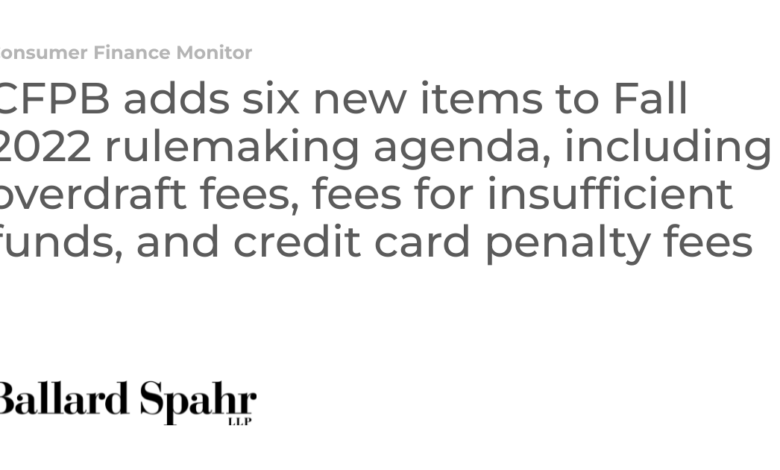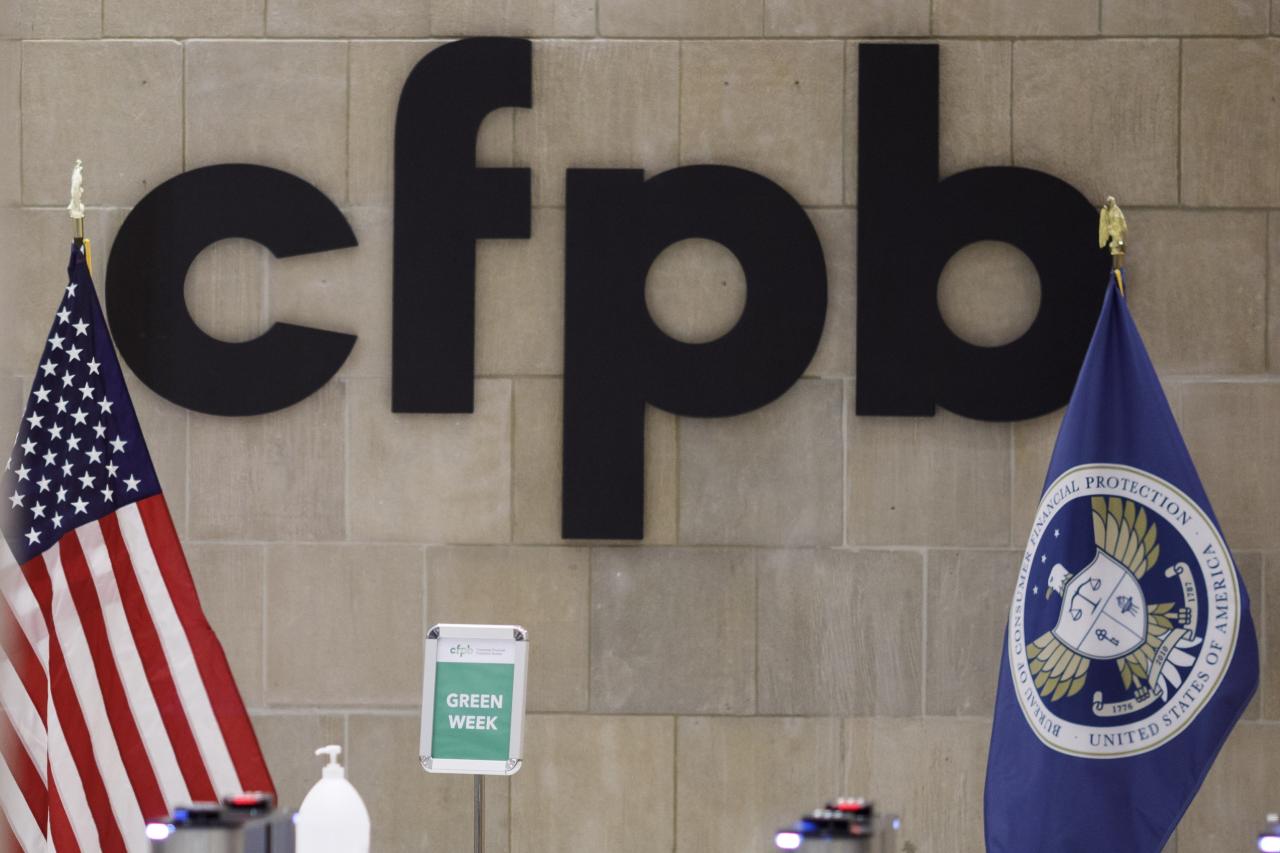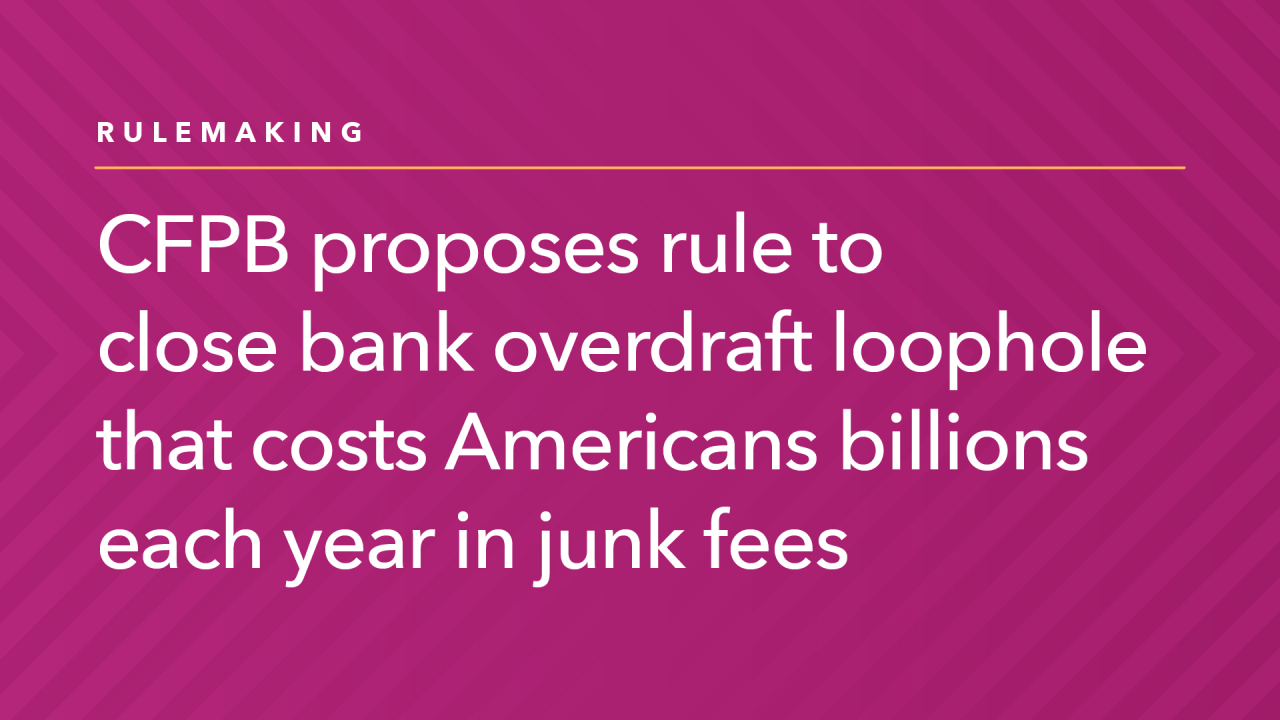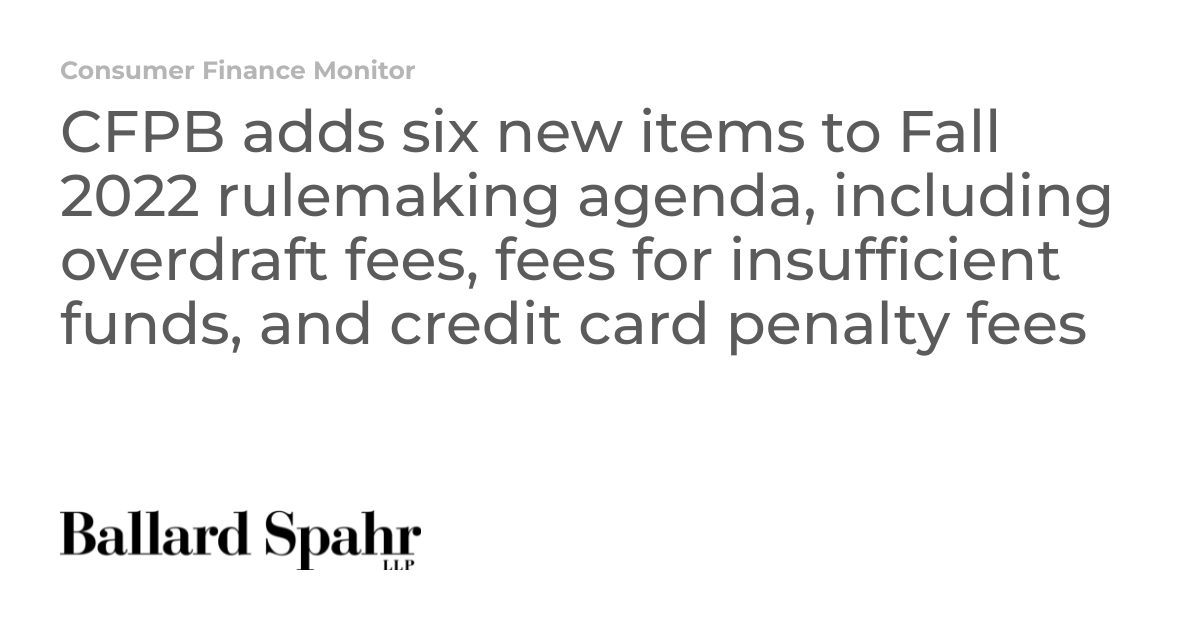
CFPB Bank Overdraft Fees Rule A Deep Dive
CFPB bank overdraft fees rule sets the stage for a fascinating exploration into the complexities of banking fees. This rule, recently implemented, aims to reshape how banks handle overdraft charges, potentially impacting both consumers and financial institutions. Understanding the intricacies of this regulation is key to navigating the changing landscape of personal finance.
This in-depth look delves into the historical context, key provisions, and anticipated impact of the CFPB’s overdraft fee rule. We’ll examine how this rule might affect various types of bank accounts, the potential financial implications for banks and consumers, and the steps involved in implementation and enforcement.
Background of the CFPB Bank Overdraft Fees Rule

Overdraft fees have long been a contentious issue in the banking industry, raising concerns about fairness and transparency. Consumers often face significant costs for exceeding their account balances, leading to financial hardship for many. The CFPB’s rulemaking effort aimed to address these concerns and protect consumers from potentially unfair and abusive practices.The evolution of overdraft fees and the corresponding consumer protection regulations has been a complex and often controversial journey.
Early banking practices often lacked transparency regarding these fees, resulting in substantial financial burdens for consumers. The CFPB’s rule, therefore, aimed to establish a more equitable and predictable framework for managing overdraft transactions.
Historical Overview of Overdraft Fees
The practice of charging overdraft fees has existed for decades. Initially, these fees were often shrouded in ambiguity, with little transparency about the specific costs associated. Early examples often involved substantial charges levied without clear justification. Over time, some banks developed more detailed fee structures, yet the lack of standardization and consumer awareness often led to significant financial burdens for many.
Evolution of Consumer Protection Regulations
Consumer protection regulations regarding overdraft fees have gradually evolved. Early regulations focused on general banking practices, but specific protections for overdraft transactions remained limited. As consumer awareness and advocacy groups highlighted the issue, regulatory bodies began to address the need for greater transparency and fairness. State-level regulations played a crucial role in initiating these changes. The emergence of national-level regulations further solidified the need for standardization and consumer protection.
Key Motivations Behind the CFPB’s Rulemaking Effort
The CFPB’s rulemaking initiative stemmed from several critical factors. Firstly, consumer complaints regarding overdraft fees consistently highlighted the financial strain they imposed. Secondly, the lack of transparency and standardization across different banks fueled concerns about unfair and predatory practices. Finally, the desire to create a more equitable and predictable system for managing overdraft transactions was a key motivation.
Table: Timeline of Key Events
| Year | Event | Description of Impact |
|---|---|---|
| 1990s | Rise of ATM usage and debit cards | Increased frequency of overdraft transactions, highlighting the need for clear fee structures. Banks began charging more frequently for overdrafts, leading to increased consumer concerns. |
| 2000s | Increased consumer advocacy | Consumer groups began to actively challenge the lack of transparency and fairness in overdraft fees. This led to more public awareness of the issue and put pressure on regulatory bodies. |
| 2010s | CFPB rulemaking on overdraft fees | The CFPB proposed and implemented regulations to address transparency, fairness, and consumer protection in overdraft transactions. The rule aimed to provide consumers with greater clarity and control over their accounts. |
Key Provisions of the Rule
The CFPB’s overdraft fee rule, a significant update to prior regulations, aims to create a fairer and more transparent system for consumers regarding bank overdraft fees. This rule significantly impacts how banks can charge for overdrafts, aiming to protect consumers from potentially excessive or unfair fees. It establishes clear guidelines and limits on permissible practices, aiming to provide consumers with more control over their finances.
Permissible Overdraft Practices
The rule Artikels permissible practices for banks to offer overdraft protection. Banks can offer overdraft services, including linked accounts or pre-authorized payments, but must clearly disclose the associated fees and terms. This transparency is crucial for informed consumer decisions. Crucially, these practices must adhere to the Artikeld regulations to ensure fair treatment for consumers. Examples of permissible practices include providing options for pre-authorized transfers from linked accounts to cover overdrafts, as long as the associated fees are disclosed and transparent.
Impermissible Overdraft Practices
The rule also specifies practices that are deemed impermissible. These include hidden fees, misleading disclosures, and practices that unfairly burden consumers. Banks are prohibited from charging excessive or confusing fees, especially if they are not transparently communicated. Examples of impermissible practices include charging fees for an overdraft protection service that isn’t actually used, or charging fees that aren’t clearly Artikeld in the account agreement.
Additionally, the rule addresses the use of deceptive language or misleading marketing tactics related to overdraft protection.
The CFPB’s new bank overdraft fees rule is definitely a game-changer, impacting how banks charge for those pesky overdrafts. But think about this – the lavish snow polo matches in St. Moritz, a symbol of luxury and tradition, are also facing the harsh reality of climate change, impacting the very conditions that allow for these events. Snow polo in St.
Moritz is a prime example of how seemingly unrelated things can be connected, and it reminds me of how the CFPB’s rule, while focused on consumer protection, ultimately addresses the broader issue of financial fairness and responsibility in the face of economic realities. It’s all about striking a balance.
Comparison with Previous Regulations
The CFPB’s overdraft fee rule represents a substantial change from previous regulations. A key difference lies in the increased emphasis on transparency and consumer protection. Previous rules often lacked explicit details regarding fee disclosure, leading to inconsistencies and potential consumer exploitation. The new rule addresses these issues with more specific guidelines.
| Aspect | Previous Regulations | CFPB Rule |
|---|---|---|
| Fee Disclosure | Vague and inconsistent | Detailed and mandatory |
| Overdraft Protection Options | Limited guidance | Explicit requirements for clarity and transparency |
| Consumer Protections | Limited or absent | Explicit provisions for consumer rights and protections |
Impact on Different Account Types
The rule’s impact varies across different account types, affecting checking accounts, savings accounts, and even credit lines in some cases. For checking accounts, the rule mandates clear fee structures and disclosures, impacting how banks structure their overdraft protection programs. Savings accounts, often used as a buffer against overdrafts, are not directly targeted by the rule, but banks are required to ensure that the services associated with them are not misused to generate overdraft charges.
For accounts that allow for credit lines, the rule might impact the relationship between those credit lines and overdraft fees, ensuring that consumers are aware of all charges involved. This impacts the financial decisions of consumers who use these accounts.
Impact on Banks and Consumers: Cfpb Bank Overdraft Fees Rule
The CFPB’s overdraft fee rule is poised to reshape the financial landscape for both banks and consumers. This rule aims to provide more transparency and fairness in how overdraft fees are charged, impacting the profitability of banks and potentially altering how consumers manage their accounts. Understanding the potential consequences for both sides is crucial to navigating this evolving financial environment.The rule’s primary goal is to curb excessive overdraft fees, and this will inevitably affect banks’ revenue streams.
The rule forces banks to be more cautious in how they structure their overdraft protection plans. This careful consideration might translate into changes in the products offered and the overall banking experience. Ultimately, the impact will depend on the specific strategies banks employ to adapt.
Financial Implications for Banks
Banks face a variety of potential financial repercussions due to the new regulations. Reduced revenue from overdraft fees is a significant concern, especially for institutions that heavily rely on these charges for profit. This decrease in revenue could lead to adjustments in pricing models for other banking services, impacting the overall profitability of the bank.
- Reduced Profit Margins: Banks that heavily rely on overdraft fees for a portion of their profit may see a substantial decrease in their overall revenue. This can impact their ability to offer competitive interest rates, loan products, or other financial services to customers. For example, a community bank heavily reliant on these fees may have to consider raising fees on other services, or reducing staff, to offset the loss.
- Increased Compliance Costs: Banks need to invest in systems and staff to ensure compliance with the new regulations. This includes implementing new fee structures, revising their terms and conditions, and potentially hiring compliance officers. Examples include updating software to manage overdraft accounts according to the new guidelines.
- Changes in Product Offerings: Some banks may alter their product offerings to compensate for the reduced overdraft fee income. This could involve introducing new financial products or adjusting existing ones to better meet consumer needs while adhering to the regulations. This could be seen in the introduction of more flexible overdraft protection options or alternative fee structures.
Potential Changes in Consumer Behavior
The rule is likely to influence how consumers utilize overdraft protection services. Consumers may become more aware of the costs associated with overdraft fees and adjust their spending habits accordingly.
- Increased Awareness of Costs: Consumers are more likely to be aware of the actual cost of overdraft fees, leading to more careful spending and budgeting. This awareness could translate to a greater focus on avoiding overdrafts altogether.
- Shift in Payment Methods: Consumers may explore alternative payment methods, such as using debit cards less frequently or relying more on digital wallets or other services. This may include using online payment platforms for bill payments to avoid the possibility of overdraft charges.
- Changes in Account Management: Some consumers may change their account management strategies, opting for higher-value accounts or more careful monitoring of their balance to avoid overdraft situations. For instance, consumers might adjust their spending habits to align with their available funds.
Impact on Small Banks vs. Large Banks
The rule’s impact may differ significantly between large and small banks.
- Disproportionate Effect on Small Banks: Small banks often rely more heavily on overdraft fees for revenue compared to larger institutions. The reduced revenue from these fees could have a disproportionately negative impact on their financial stability and ability to offer services. For example, smaller banks may face challenges in absorbing the increased compliance costs.
- Different Resources and Capacity: Large banks often have greater resources and technological capacity to adapt to the new regulations, while small banks might find it more challenging to implement the necessary changes. This difference in resources can impact the ability of small banks to provide similar services.
- Adaptability and Innovation: Small banks might need to be more innovative in developing alternative revenue streams and services to compensate for the reduced overdraft fee income. This might involve offering more competitive interest rates on savings accounts or exploring partnerships with fintech companies.
Influence on Alternative Financial Services
The rule might stimulate growth in alternative financial services that provide overdraft protection or financial management tools.
- Growth of Fintech Solutions: Fintech companies specializing in overdraft protection or financial management tools may experience increased demand and market share. This is due to consumers seeking more affordable and accessible options.
- Shift in the Financial Landscape: The rule could potentially lead to a shift in the financial landscape, with consumers increasingly utilizing alternative financial services instead of traditional bank overdraft protection. This shift could benefit fintech companies and disrupt traditional banking models.
Implementation and Enforcement

The CFPB’s overdraft fee rule isn’t just a set of guidelines; it’s a complex process demanding meticulous implementation and robust enforcement to ensure fair treatment for consumers. Successfully implementing and monitoring compliance requires a multi-faceted approach, addressing potential challenges head-on. This involves a structured plan for banks to adopt the new rules, mechanisms to track their compliance, and a system to address violations.The rule’s effective implementation is critical to ensuring that banks understand and comply with the regulations.
The CFPB’s new bank overdraft fees rule is definitely a hot topic right now. It’s all about fairness and transparency in banking practices. Recently, though, the news about Chris Young’s charges being dropped ( chris young charges dropped ) has certainly taken center stage. Regardless of this unrelated legal drama, the CFPB’s overdraft rule is still crucial for consumers and their financial well-being.
Hopefully, it will finally lead to fairer practices for those using overdraft protection.
Monitoring compliance is equally important to detect and address any discrepancies early on, preventing unfair practices and protecting consumer rights.
Implementation Process
The CFPB’s overdraft fee rule implementation involves a phased approach, allowing banks to adjust to the new requirements gradually. This phased approach aims to mitigate potential disruptions to banking services and support the smooth transition for both banks and consumers. It’s crucial that banks understand the deadlines associated with each phase of implementation. Banks need to be well-informed and prepared to meet the new regulations by the prescribed deadlines.
Monitoring Compliance
The CFPB employs several methods to monitor compliance by banks. These include regular audits, data analysis, and consumer complaints. This multifaceted approach provides a comprehensive view of compliance across the banking sector. Regular audits ensure that banks are adhering to the specific rules, while data analysis identifies patterns or trends that may indicate non-compliance. Consumer complaints provide a direct feedback mechanism, allowing the CFPB to identify widespread issues or areas of concern.
By combining these methods, the CFPB aims to create a robust system for detecting and addressing non-compliance issues.
Enforcement Actions
The CFPB has a range of enforcement actions at its disposal to address non-compliance with the overdraft fee rule. These actions can vary in severity, depending on the nature and extent of the violation. Examples of potential enforcement actions include cease-and-desist orders, civil penalties, and even the requirement to refund overdraft fees to affected consumers. The CFPB will also provide clear communication regarding the reasons for the enforcement action.
Compliance Process Steps
| Step | Description |
|---|---|
| 1. Review the Rule | Banks meticulously review the CFPB’s overdraft fee rule, understanding the specific provisions, requirements, and limitations. |
| 2. Internal Training | Banks provide comprehensive training to their staff, ensuring that all employees understand their responsibilities and obligations under the new rule. |
| 3. System Updates | Banks implement necessary changes to their systems to accurately reflect the updated overdraft fee guidelines and accurately calculate fees. |
| 4. Policy Revisions | Banks revise their internal policies and procedures to align with the overdraft fee rule, ensuring that these policies are easily accessible and understood by consumers. |
| 5. Compliance Monitoring | Banks establish a system to monitor compliance with the rule, tracking fees charged and ensuring that they are applied correctly. |
| 6. Consumer Communication | Banks inform consumers about the changes to overdraft fees and associated policies, providing transparent and easily understood information. |
| 7. CFPB Reporting | Banks submit required reports to the CFPB to demonstrate compliance with the new overdraft fee regulations. |
Alternatives and Future Considerations

The CFPB’s overdraft fee rule represents a significant shift in the financial landscape, aiming to protect consumers from potentially abusive practices. However, the rule’s implementation necessitates a nuanced understanding of its potential impact, alongside exploring alternative strategies and future considerations for both banks and consumers. The financial technology landscape is constantly evolving, and the rule’s long-term effectiveness depends on adapting to these changes.This section explores potential alternatives to managing overdraft risk, identifies emerging trends that could influence the rule, and suggests ways to improve its effectiveness and consumer education.
These are not mutually exclusive solutions, but rather complementary approaches that can lead to a more equitable and sustainable financial system.
Potential Alternative Approaches to Managing Overdraft Risk
The overdraft fee rule’s primary objective is to discourage banks from charging excessive fees. Alternative approaches could include a combination of proactive and reactive measures. For instance, banks might implement tiered pricing models, offering lower overdraft fees for smaller amounts or for customers with a history of responsible financial management. This could incentivize responsible spending habits and reward responsible financial practices.
The CFPB bank overdraft fees rule is a hot topic, and it’s definitely something I’m keeping an eye on. It’s fascinating to see how these financial regulations are impacting consumers, especially given recent news like the hiring of Arthur Smith as the Steelers’ offensive coordinator ( arthur smith hired steelers offensive coordinator ). While the two seemingly disparate topics might seem unrelated, the ripple effects of financial policy can sometimes surprise us.
Ultimately, the CFPB rule’s long-term impact on banking practices remains to be seen.
Another approach involves educating consumers on budgeting and financial planning, empowering them to avoid overdraft situations.
Emerging Trends in Financial Technology and Their Influence on the Rule
The fintech sector is rapidly changing how financial services are delivered. Mobile-first payment solutions, such as peer-to-peer (P2P) transfers and mobile wallets, are altering how consumers interact with their money. These technologies can potentially reduce the reliance on overdraft services by providing alternative payment methods and facilitating immediate funds transfers. Furthermore, the rise of robo-advisors and AI-powered financial planning tools could empower consumers to proactively manage their finances and avoid overdraft situations.
The rule’s long-term impact will be heavily influenced by the continued evolution of these technologies.
Improving the Rule’s Effectiveness and Future Regulations
The CFPB’s rule sets a baseline for responsible overdraft practices, but future regulations might consider certain factors. For instance, clearer definitions for “unfair” or “excessive” fees could further enhance the rule’s effectiveness. Additionally, considering the unique financial circumstances of different consumer groups, such as low-income households or those with limited access to financial resources, could lead to more tailored solutions.
The CFPB’s new bank overdraft fees rule is a big deal, right? It’s definitely going to shake things up, but the recent court victory for Thailand’s Pita Limjaroenrat in this case highlights the broader issues around financial regulations. Ultimately, the CFPB’s rule is about protecting consumers from potentially predatory overdraft practices, a vital step in ensuring fairer financial landscapes.
This could potentially involve partnerships with community organizations to provide financial literacy programs, making the rule more equitable and effective for all segments of the population. Regular review and adjustment of the rule, based on data and feedback, is crucial for its long-term effectiveness.
Educating Consumers About the Rule’s Implications
Effective consumer education is paramount to the success of the overdraft fee rule. Clear and concise information about the rule’s key provisions should be disseminated through various channels, including financial institutions’ websites, educational materials, and partnerships with financial literacy organizations. This includes explaining how the rule impacts different types of overdraft services, such as temporary or recurring overdrafts, and how consumers can avoid overdraft fees in the future.
Financial institutions should also provide clear explanations of the associated fees and the conditions under which they may be applied. A concerted effort to demystify the rule and make it understandable to the average consumer is crucial.
Illustrative Scenarios
The CFPB’s overdraft fee rule aims to protect consumers from excessive and unfair fees. Understanding how this rule impacts banks and consumers requires looking at real-world scenarios. These examples highlight the potential benefits and challenges associated with the new regulations.
The CFPB’s new bank overdraft fees rule is definitely a hot topic, but it’s interesting to see how it’s all connected to other big news. For example, the ongoing legal battles surrounding the Trump trial judge campaign are causing a ripple effect, potentially influencing the final outcome of the overdraft rule. This ongoing legal wrangling could significantly impact the future of the CFPB bank overdraft fees rule, making it a fascinating area to watch.
trump trial judge campaign is definitely a factor in the discussion. Ultimately, the rule’s fate remains to be seen, but it’s clear that many things are intertwined.
Successful Bank Implementation, Cfpb bank overdraft fees rule
Banks can successfully implement the rule’s provisions by proactively adjusting their overdraft policies and procedures. This involves a clear and transparent communication strategy, informing customers about the new fee structure and alternative options. A bank might offer tiered pricing based on the amount of the overdraft, ensuring a fair balance between customer convenience and bank profitability. This approach would likely result in a more customer-centric banking experience, attracting and retaining customers.
For example, Bank A might introduce a tiered system with lower fees for smaller overdrafts and higher fees for larger, recurring overdrafts, coupled with clear explanations in their account statements. This can avoid customer confusion and potential disputes.
Challenges in Compliance
Some banks might face challenges in complying with the rule due to existing contracts or technological limitations. Adjusting existing systems to accommodate the new requirements might require significant investments in software and training. The complexity of the rule, including different interpretations of certain provisions, could also cause uncertainty and delays in implementation. For instance, a small community bank with limited resources might find it challenging to adapt its existing infrastructure to meet the new standards.
They might require additional support from financial advisors or software vendors to achieve compliance.
Consumer Benefits
Consumers stand to gain from the rule by having more predictable and transparent overdraft fees. This transparency helps consumers make informed financial decisions, allowing them to avoid excessive charges. The rule’s focus on alternative options, such as overdraft protection plans, can help consumers manage their finances more effectively. For example, a consumer with a tight budget, such as a student or young professional, might be able to avoid significant financial penalties by utilizing the rule’s alternative options.
A consumer who frequently overdrafts their account might now benefit from a clear understanding of the associated fees and can potentially adjust their spending habits accordingly.
Last Word
In conclusion, the CFPB bank overdraft fees rule represents a significant shift in the banking industry, aiming to balance the interests of consumers and financial institutions. The rule’s impact will undoubtedly be felt throughout the banking sector, prompting adjustments in practices and potentially encouraging alternative financial solutions. The future of overdraft management seems poised for a period of transformation.
Essential Questionnaire
What are some common misconceptions about the rule?
Many believe the rule prohibits all overdraft fees. However, the rule focuses on transparency and fair practices, not complete elimination. It aims to ensure consumers understand the fees and are not caught off guard by hidden charges.
How does the rule affect small banks differently from large banks?
Small banks might face greater challenges in adapting to the rule’s complexities, potentially needing more resources for compliance. Large banks, with established compliance teams, might find the transition smoother. However, both types of institutions are subject to the same regulations.
What are some potential alternative approaches to managing overdraft risk?
Alternatives include offering overdraft protection programs with clear terms, educating consumers about budgeting and responsible spending, and exploring alternative financial solutions like prepaid cards or mobile payment options.

